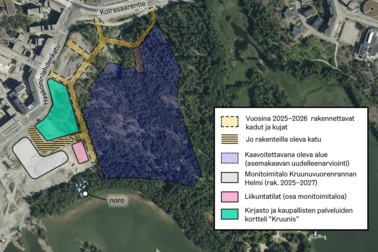
The new architectural programme states that architecture in Helsinki will be developed by focusing on architecture of the everyday, public urban spaces, climate-smart construction, participation of citizens and communication about architecture.
“The architectural programme is based on the City’s strategic goals and city planning policies, while also keeping global changes in mind. The programme features 27 measures for achieving the goals. Realising the programme is a joint effort for the whole city,” says Chief Design Officer Hanna Harris.
Helsinki offers insightful architecture of the everyday
According to the programme proposal, Helsinki aims to be a place that offers everyday architecture that meets people’s needs. Important places in regard to this goal include residential buildings, schools, daycare centres, public transport hubs and other public spaces in particular.
Helsinki intends to advance initiatives such as the preparation of colour guidelines for architecture and investing in suburban regeneration areas. Additionally, the City will hold architecture competitions on notable public buildings and the first blocks in new areas.
Architecture can also be one way to elevate an area’s image and prevent social exclusion. For Helsinki, architecture and design are also an internationally significant way to stand out. These efforts will be supported by promoting the new museum of architecture and design, among other means.
Helsinki will offer attractive natural environments and urban spaces
Helsinki is a city that values its local nature, parks and maritime atmosphere and recognises their impact on wellbeing. The City will plant trees along streets, replace lawns with meadows and increase urban farming opportunities for residents. The number of green roofs will be increased.
Helsinki also intends to improve the overall attractiveness of urban spaces by means of art and lighting and by initiating the preparation of a public urban space strategy. Outdoor lighting will be designed as a fixed part of urban spaces and the landscape.
Construction will be carried out in a climate-smart and sustainable manner
The City of Helsinki’s aim is to become carbon-neutral by 2030. In the architectural programme, architecture and construction are harnessed for resolving and adapting to the climate crisis.
The lifecycle emissions of construction will be reduced further, and old buildings will be repaired and refurbished skilfully. Helsinki will prepare and adopt sustainability and climate criteria for architectural and plot conveyance competitions. Helsinki will investigate establishing a building element bank to promote circular economy.
Helsinki will create a great environment by utilising many methods
Helsinki will be designed together with its residents and by means of multidisciplinary design. The City will employ design thinking and new digital tools to design a future-proof environment. Helsinki will focus on the inclusion of children and young people and a child-oriented approach to city planning. The City will also focus on communicating about architecture to various target groups.
Architectural policy programmes offer broad tools
Finland has been an international pioneer with its first national programme that was published in 1998. The latest national programme, ‘Towards Sustainable Architecture: Finland’s National Architectural Policy Programme 2022–2035’, was published in 2022.
Finnish cities and municipalities have also been writing their own programmes since the 2000s. The Helsinki City Strategy 2021–2025 states that during this strategy term, the Helsinki architectural programme will be completed.
”With the architectural programme, we are paving the way for the City of Helsinki’s operations and also inviting others to treasure high-quality architecture,” says Executive Director of the Urban Environment Division Ville Lehmuskoski.
The programme proposal’s themes were discussed at a launch event on 18 April by Head of Detailed Planning Marja Piimies, Housing Development Manager Sanna Meriläinen, Head of Urban Space and Landscape Planning Jussi Luomanen, Head of Building Control Leena Immonen, Museum Director Reetta Heiskanen, Project Director Susa Eräranta from the City’s Climate unit and Communications Manager Heikki Mäntymäki from the City of Helsinki. Chief Design Officer Hanna Harris presented the programme and moderated the discussion. The event was opened by Deputy Mayor Anni Sinnemäki and Executive Director of the Urban Environment Division Ville Lehmuskoski. Senior Ministerial Adviser Emma Harju from the Ministry of Education and Culture and Regional Architect Anna-Riitta Kujala from the City of Vantaa provided commentaries.
The Urban Environment Committee will consider the proposal of the programme on Tuesday 23 April.


